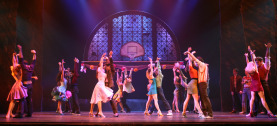West Side Story — a new production of the great musical by Leonard Bernstein, Arthur Laurents, Stephen Sondheim, and of course Jerome Robbins — has arrived on Broadway, opening last night. It’s an event.
 Since I haven’t seen it yet, I asked my friend Amanda Vaill — who has — to weigh in. Amanda wrote both Somewhere: The Life of Jerome Robbins (2006) and Jerome Robbins: Something to Dance About, the American Masters documentary that aired on PBS last month. Robbins was billed as the choreographer, director and conceiver of the 1957 original production, which was seen as a radical show.
Since I haven’t seen it yet, I asked my friend Amanda Vaill — who has — to weigh in. Amanda wrote both Somewhere: The Life of Jerome Robbins (2006) and Jerome Robbins: Something to Dance About, the American Masters documentary that aired on PBS last month. Robbins was billed as the choreographer, director and conceiver of the 1957 original production, which was seen as a radical show.
What was Robbins trying to do with his staging of West Side Story?
What changes have been made, why, and do they work?
Other changes cut more painfully into Robbins’s design, though.
The “Somewhere” ballet, for instance, has been shorn of its second half, in which the tenement walls closed in around the sunlit dreamworld Tony and Maria had imagined for themselves, and the chaos of the first-act rumble was reenacted. That segment made the passion with which the lovers clung to each other in the succeeding scene all the more urgent and poignant — it’s a shame to lose it.
And instead of of having an offstage soprano sing “Somewhere,” as if giving voice to Tony’s and Maria’s thoughts, the song is now given to a mop-haired boy soprano who sings it to Tony and Maria — an inexpressibly mawkish touch that Robbins, whose use of children in theater was never bathetic, would have recoiled from. Finally, the show’s ending dispenses with the ritual bearing away of Tony’s body by both Jets and Sharks, precariously united in grief. Laurents says the police would never allow anyone to tamper with a crime scene in this way — to which I’m tempted to reply, “Gee, Officer Krupke, krup that.” I want my catharsis.
Photo: “The company.” Credit: Joan Marcus
